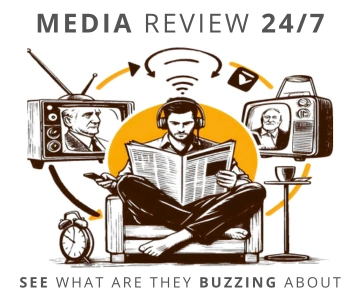The early 19th century brought technological advances. With steamboats, railroads, and telegraph, communication escaped the "age of wind and horses." The invention of the steam cylinder press lowered printing costs, and wider education meant more people could and wanted to read. Publishers realized the future of the press lay in accessibility - low cost and approachable content. Many were staunch reformers, openly supporting common people and opposing slavery.
By combining national pride, idealism, and open-mindedness, these newspapers soon became a popular medium for instilling American ways of life and thought into waves of immigrants from around the world. By 1820, the U.S. had around 25 daily newspapers and over 400 weeklies. In 1841, the most influential newspaper of the time was established by Horace Greeley - "The New York Tribune."
Other significant newspapers, such as "The New York Times," "Baltimore Sun," and "Chicago Tribune," emerged around 1850. However, true media magnates built their empires in the most turbulent times - right after the Civil War. There were two fierce rivals who waged relentless battles: Joseph Pulitzer and William Randolph Hearst. To attract readers, they resorted to "yellow journalism," now known as tabloid journalism, filled with sensation and scandal. Their "blood on the front page" approach drew readers with a taste of tragedy and death.
From this era comes Pulitzer’s famous saying, "Never print anything your maid can`t understand," reflecting the level of newspapers of that time. Murders, scandals, disasters, and accidents captivated 19th-century America. The essence of "blood on the front page" journalism was embodied by "The New York Daily News," published in tabloid form on yellow paper. Like other tabloids, it focused on sensationalism and entertainment, with short texts, shocking photos, comics, and advertisements that eventually took up half of the paper. As tabloids were sold at very low prices, much lower than production costs, they relied almost entirely on advertising revenue.
In the early 20th century, newspaper publishers realized that the best way to retain readers was to provide a complete, unbiased picture of events. These standards of objective journalism remain among the finest traditions of American reporting. Another characteristic of the media industry from that time is the creation of large media corporations. The Hearst empire, which controlled about 75% of all newspapers, exemplifies this.
Today, American media is still dominated by large and influential corporations. In 1990, there were 135 in the U.S., managing a total of 1,228 newspapers. As in Europe, the power of the press diminished drastically with the advent of radio and even further with television. Most "afternoon editions" were suspended as readers preferred TV news or radio updates. In 1971, afternoon papers numbered around two per day in 66 cities, but by 1995, they had dwindled to 36.
Over the past 50 years, the number of newspapers has decreased from 1,772 in 1950 to 1,480 in 2000. However, weekend editions have gained popularity, increasing from 549 in 1950 to 917 in 2000. Despite declining readership, the United States still has the highest number of newspapers in the world, with a total circulation of 115 million copies!
Investigative journalism and the "watchdog" role, granted to the media by the Constitution and other regulatory acts, developed in the 1960s. The Vietnam War era was the greatest test for the American press. Publishers had to choose whether to follow national policy guidelines or present the unfiltered public opinion. This period marked the rise of journalistic ethics.
Most American media followed the path of conscience, contributing to the U.S. withdrawal from the Vietnam conflict. During the Watergate investigation, journalists (this time from "The Washington Post"), Bob Woodward and Carl Bernstein, once again proved that the press could influence politics rather than simply being its "tame pet." Unfortunately, media freedom was not always upheld. Numerous examples and court decisions indicate that over the past decades, the balance between the public`s right to information and public figures` right to privacy remains unresolved. I will discuss these controversial cases in a future segment of "The Fourth Estate in America."
In the first episode of our series, I covered the "big five" of American press:
- "Wall Street Journal",
- "USA Today",
- "New York Times",
- "Los Angeles Times"
- and "Washington Post".
The youngest in this group, "USA Today," was founded by the Gannett group in 1982. Its success stemmed from extensive market research prior to its launch. This led the publisher to emphasize what the average American wanted - bold graphics, large color photos, short articles with catchy intros, catering to busy city dwellers looking for quick news rather than lengthy, in-depth stories.
Today, newspapers must compete not only with television but with a wide array of specialized media. Personalized online services, local cable stations, interactive television, specialized publications, catalogs, and other direct mail initiatives all vie for readers` attention. To meet reader demands and stay competitive, newspapers must embrace new technologies. Through the Internet, digital versions reach personal computers, new printing methods allow wider reach, faster and in higher quality. Market research experts are employed to determine what sells best and how to present it. In media, as in any business, money is paramount. Journalists, however, still have a mission to fulfill. Do they manage to reconcile modern-day demands with journalistic ethics? Learn about this and niche, opinion-shaping magazines in the next installment.
Read all articles in the series The Fourth Estate in America.
COMMERCIAL BREAK
New articles in section History of the media
The History of The New York Times. All the news that's fit to print
Małgorzata Dwornik
In the heart of 19th-century New York, when news from across the world traveled via telegraph and the newspaper was the voice of public opinion, two ambitious journalists created a modest four-page daily that would eventually become a legend.
FORTUNE. The story of the most exclusive business magazine
Małgorzata Dwornik
Half of the pages in the pilot issue were left blank. Only one printing house in the country could meet the magazine’s quality standards. They coined the terms "business sociology" and "hedge fund". They created the world’s most prestigious company ranking. This is the story of Fortune.
History of Le Soir. A Belgian daily once free for ground floor readers
Małgorzata Dwornik
It started with an unusual sales policy and articles written personally by the king. This is where the comic hero Tintin made his name. The "fake edition" from the II World War went down in history. "Le Soir" more than once found itself targeted by authorities, censors, and even... terrorists and hackers.
See articles on a similar topic:
Mada Masr. History of Egyptian online newspaper that started on a beach
Małgorzata Dwornik
On June 17, 2013, at the first editorial meeting, everyone sat on the floor. There were no chairs. There were no desks or money either. But there was passion, 17 ready articles, and a nameplate on the door: Office of the Artists Formerly Known as "Egypt Independent".
Larry King. One man, 50 thousand interviews
BDw
A few minutes before his first radio broadcast, Lawrence Zeiger heard that his last name wouldn’t do. "Too hard. Too ethnic". The boss looked at a newspaper lying nearby. An ad for a liquor wholesaler caught his eye: King`s Wholesale Liquor...
Le Nouvelliste. History of Haiti's oldest daily newspaper
Małgorzata Dwornik
Surviving its first year only due to a wine and potato importer, it held a monopoly on news from France. It meticulously avoided blending news with commentary - until the U.S. occupation of Haiti in 1915. It was elevated to the top by a trio known as the "Holy Monsters". Thus begins the story of the Haitian daily, Le Nouvelliste.
History of Public Relations. From Ancient Times to a Field of Study
Małgorzata Dwornik
Public Relations - two words we come across several times daily. We hear them on TV and radio, and read them in newspapers. PR - two letters that can sometimes cause quite a stir.






























